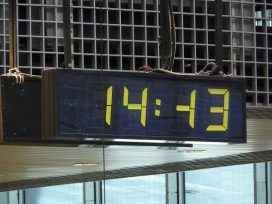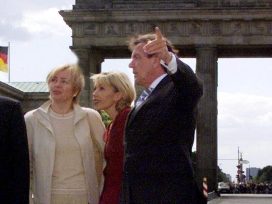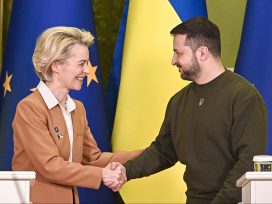One of Russia’s most significant contemporary writers, Sergei Lebedev, describes the work of Gulag researcher Yuri Dmitriev in a place that both men know well: the far North. Eurozine presents Lebedev’s essay for the first time in English, translated by Antonina W. Bouis.
In December 2016, Yuri Dmitriev was arrested in the far northwest of Russia. He is a Gulag researcher, the discoverer of Stalinist camp burial grounds in Krasny Bor, Sandarmokh, and Mount Sekirnaya in the Solovki Islands,1 and the compiler and publisher of the Karelian Books of Memory.

Solovetsky Monastery. Photo: Xavi. Source: Flickr
Quite a bit has been written about the legal side of Dmitriev’s criminal case, with the trumped-up charges of child pornography and more. The charges, God willing, will be dismissed, Dmitriev will be acquitted, and he will be able to return to his real work, which he was forced to abandon due to the criminal persecution.
This text is an attempt to find a language for talking about how Yuri Dmitriev works with memory; about Dmitriev as a phenomenon, his intuitions, and research methods in uncovering some of the most horrendous crimes against humanity ever perpetrated on this earth.
A gift
There are lives that seem remarkable, but if you look closely, you’ll see that another could have done it as well.
But there are lives that are an ideal fit. You can’t imagine anyone else in that place.
Yuri Dmitriev is one of these.
Journalists call him a wizard or folk hero. At first that seems amusing and appropriate, but at some point it outruns its usefulness , as if the writers aren’t very sure what to do with Dmitriev, on what shelf to place him, how to describe him.
He is about good – and about something otherworldly; in old photos, before prison, he does resemble a wizard whose head was shaved by prison guards and deprived of his strength, like Samson.
Dmitriev is a rational man who knows what needs to be done on a practical level. There are not many people like this, they are invisible but without them human existence will stop. There is no mysticism or magic about them but rather a precise mind and a special gift.
Searching – for people of Russia’s North the word has a special meaning. Professional schools have departments of searching, with search as a speciality, investigation as a speciality.
‘Searcher’ is both a job and a gift that merges skill, luck, a sixth sense, and the intuitive knowledge that finds are not found but given and that the path to them is not only the literal one of footsteps through the taiga.
I know the searcher’s gift from geology. The most interesting mineral deposits are always on the edge, in the interstices of several kinds of ores, and it is important to feel these places of contact in the landscape, which are always not quite like the rest, slightly different from neighbouring veins.
There is the horrible gift of the searchers in the Search and Recovery Squad, to sense and detect the place of catastrophe, the combinations of circumstance that threaten death. To feel, assume, foresee where a group might have died, what killed it. Otherwise you’ll never find them, the taiga is too vast.
Dmitriev’s gift, combining the amazing skills of the archivist, the persistence of the researcher with the developed sense of a taiga specialist, is of this kind.
The gift is a calling and the sorrowful duty to search; you can’t turn it off, sublimate it, channel it into something else. Such people are living, walking radars; each is set to a certain wavelength. They can be difficult in life; the gift not only gives but takes away. They don’t care about important things and don’t understand the obvious; they don’t know how to stop, to parcel out feelings and actions, sometimes just as selectively blind as they are selective seeing, capable of clairvoyance and visions.
They are the legendary figures of the North, subjects of professional folklore, local heroes; they, who know how to find, patch together the disparate little words of the North into something whole; the searchers and guides are the first agents of civilization; the trailblazers who create roads. Yuri Dmitriev is restoring civilization to the places where it had been once before, in the diseased and anti-civilizational form of the Gulag, leaving behind the hidden ulcers of nameless camp graves.
Space marker
Once, when I was working in the Prepolar Ural, we came across a General Staff terrain map covered with strange names for rivers and streams: Alphashor, Betashor, Gammashor – and so on to Omegashor. ‘Shor’ in the Komi language is ‘stream.’ The Greek alphabet was used by Soviet topographers clearly tired of coming up with names like ‘Fast’ or ‘Long.’ I was stunned that you can take a piece of space and use it for a simple joke, as if it were a piece of paper; write whatever you want on top of it, and the space, like paper, will tolerate it, for the aborigines do not have the power to create maps, and their toponyms, their long memory encoded in names, do not fit History with a capital H, and they do not know (or are not allowed) to represent themselves with commonly used memorializing symbols.
Why did this episode come up in relation to Dmitriev? Because he is a space marker. He doesn’t simply do symbolic things, he is like a demiurge, working directly with existence, with the body of the country spread out on the map, rewritten by the Soviet regime, not by returning names but by creating them, tragic chronotopes that will be places of memory. The NKVD shot camp prisoners on a nameless kilometre of the road between Medvezhyegorsk and Povenets, in an unremarkable wood. Dmitriev came, found the graves, learned the name of the nearby tract, and Sandarmokh appeared.
This is an extremely important story. All the northern camps – those that followed new mining sites such as Karelia, Kolsky, Vorkuta, Norilsk, Kolyma – with rare exception existed in bare geography, not in history. History came to those parts in the form of camp barracks, and there was no historical or cultural layer beneath them; there was no cultural milestone nearby to which memory could be attached. When the camps were closed, the location returned to its natural existence, to nature’s lack of memory and indifference to the preservation of evidence: the barracks rotted, the bridges washed away, the roads were covered by forest, and the execution pits were covered with earth and moss.
This northern space, without a pre-camp genealogy, is highly resistant to historicizing, since it returns too easily to its original state of nothing, the dreaminess of rivers and forests. Dmitriev creates something out of the literal nothing, creates the points around which memory can crystallize and grow.
Pilgrims of the archipelago
A week after the expedition helicopter leaves, memories of the city, of the big country beyond the taiga and the mountains begin to fade. A month later you look at your passport in wonder – what is this thing, what is it for? After six weeks impressions, smells, sounds that are not needed, and without basis in the world around you are forgotten: one evening in the tent we tried to remember the fragrance of an orange – and could not: in place of the olfactory memory there was just an empty peel.
The reverse is also true: I’ve noticed many times that people living in the central regions do not sense or feel the North as part of their inner Russia. It’s somewhere far away, the tundra, the taiga …
Nazi camps are incised, forged into Germany and Poland, they cannot be excised from the geography. They are there, nearby, an hour away by train, two on the bus, next to Berlin, near by Munich, in reach of Weimar, Krakow, Warsaw.
The Stalin camps are easy to forget – they either were destroyed during city building, the industrialization of the 1960s, or are located in a vague ‘there,’ close to the abstraction of the Polar Circle, far from sight and memory.
The endless expanses of the North, Siberia, and Kazakhstan became a convenient place to hide millions of people, tearing them away from their roots, inhabited places, the very tradition of memorializing. In the North they call the rest of the country the mainland; where they are is Solzhenitsyn’s archipelago, an undefined periphery, a space of darkness if you look down from the plane flying to Magadan.
Two deaths
The millions of prisoners who were killed or died in the camps did not die just far from family. Their deaths, which appeared as statistical data in camp administration reports and as physical acts, did not enter the country’s common necropolis, that fine self-knitting web of mutual memory distributed among the living, based on the aggregate of memories that complement one another and pass through time; the aggregate supported and fed by the memorial infrastructure – funeral rites, rituals of grieving and remembering, and most importantly, by cemeteries, graves, places where the world of the dead and the world of the living meet symbolically.
There is a concept of ‘hostage dead’ in Russian folklore – people who died an unnatural death, innocently murdered, not given a proper burial. The ‘hostage dead’ do not find relief, are not fully dead, stuck between this world and the next, still alive and demanding a canonical funeral and release of their souls.
Essentially, the dead of the Gulag, many of whom are still physically uncorrupted in the permafrost of the North, are such hostage dead. You could say that they were deprived not only of life but of death – the cultural, ritual death that expresses the value of every human life, the idea of the immortal soul, and forms the basis of memory.
The denial of death, posthumous deprivation – this is what Yuri Dmitriev works with.
How he does it is important. The truth is that all is in vain – books, films, monuments – if cemeteries are not called cemeteries, if the dead are not given back their names.
Humans are those who bury their dead. If that norm is not in force, we fall back into primitive times when the body was not yet seen as the vessel of the soul and did not require special, ritual care.
And we, we have not buried our dead. We abandoned them in the taiga and tundra, in steppes and deserts, where the Gulag camps were.
I do not know what a burden this disregard (if not betrayal) of cultural and moral duty came to be on the fate of the country or how it complicated and distorted it. But I believe that this burden, this sin, is immeasurably great.
What Yuri Dmitriev is doing with intuitive accuracy is like a cleansing and elucidation of the country’s destiny.
One might think, so what – so they found the place where a man was killed and there’s nothing there, some trees and a hummock. They’re easy to imagine, they’re interchangeable. But no – this work of clarification is not for biographical details, although they are also important. Not only is a person’s life clarified, not only does justice reign – though neither justice nor revenge occurs – but something does happen: dignity is restored.
They had thrown him like a dog into a hole – in order for him not to be found, to erase his name, to make him disappear as if he had never been.
This is weighed on scales that have little to do without ordinary lives. If our common fate is determined by anyone, it is by people like Dmitriev.
The divine clue
The North, Siberia – these are ideal spaces for crime. You feel that sometimes in the taiga: either as the clear understanding that if you break your leg no one will ever find you, or as a temptation in the heat of an argument – there is no one around, no witnesses, and the taiga will hide everything. The taiga will hide everything.
Every mystery novel is built around a body. The body is the most important, God-given clue. It’s hard to hide a body, it’s big and heavy and takes a long time to decompose. But if no body is found, there’s really no crime, no criminal.
The Nazis built crematoriums in the camps. The Gulag did not need crematoriums: the spaces of the camp empire were such that you could hide, destroy millions of bodies and there would be room for more.
This is why Dmitriev’s approach is so important: find the bodies, find the burials. Do not settle for cenotaphs, symbolic graves, museum projects.
Only bodies, only execution pits will cry out about the crimes with extreme force; and I believe this is why Dmitriev is so inconvenient, so bad for today’s regime, which is prepared to erect a general monument on Sakharov Prospect, recognizing, with caveats, the victims of repressions, but these victims are separated, abstracted from the crime committed against them.
Dmitriev uncompromisingly proves the criminality of the Stalin regime, the criminality of the Soviet regime per se; he proves, forgive the tautology, with proof – presenting skeletons and skulls with bullet holes.
The silence of the dead
Everything we know about the Gulag we know from the eyewitness accounts of the living, the survivors. But there are also those who will never tell us anything, whose lives are not enough for a plot; they died and that’s it. I think that beneath the discomfiting sky of the North you clearly sense that our debates about the past have one more – invisible, silent – side. The dead have their own truth, and that is the truth of those who did NOT survive, which is more horrible than any tale of a survivor.
In some sense this truth argues with the truth of the survivors, the ones who returned. The dead did not have and will not have the chance to recall, write, reflect; their world is cut off at the Gulag, they will never leave the camp, they are trapped there.
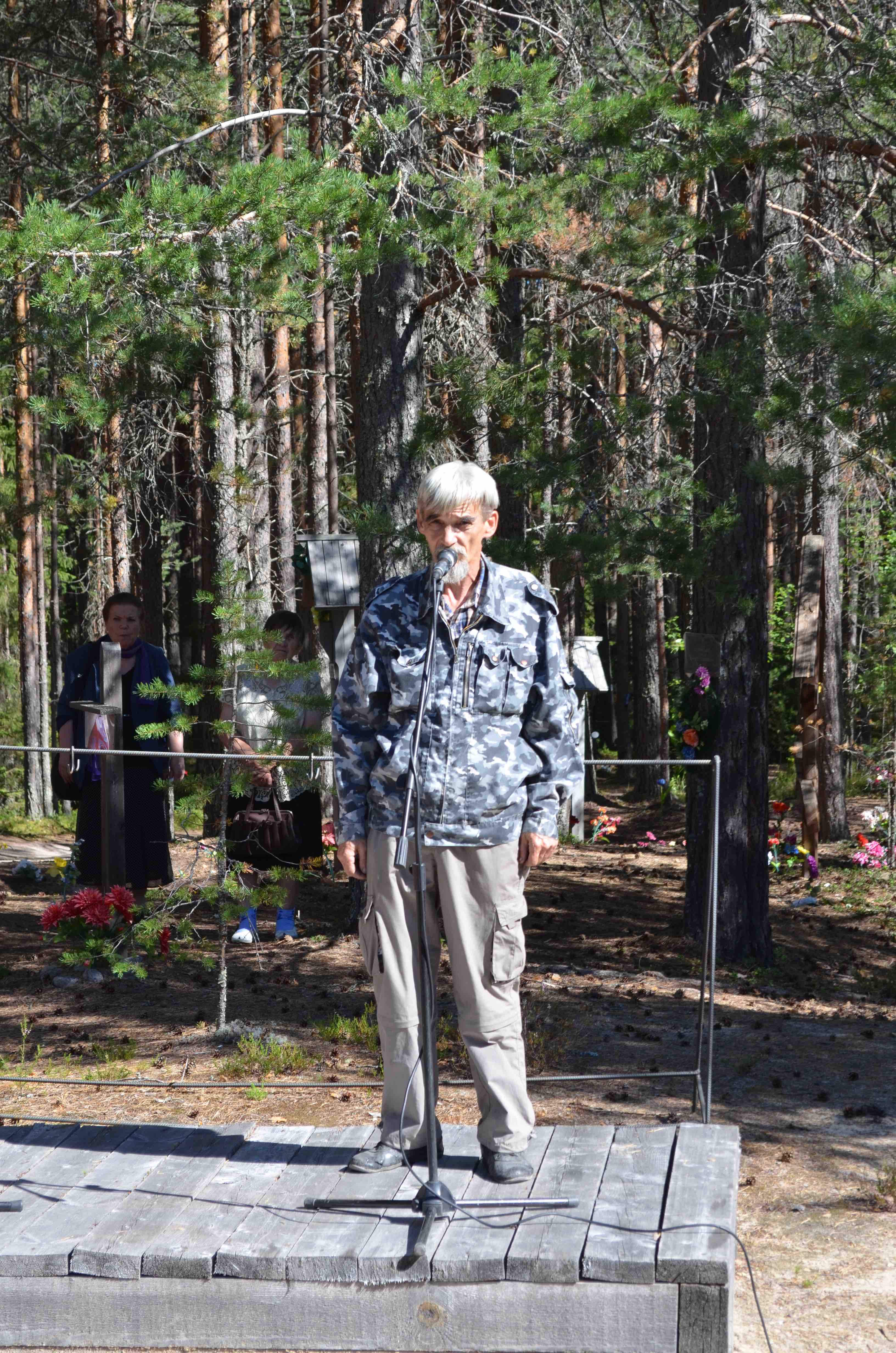
Yuri Dmitriev speaking at Sandarmokh, 5 August 2013. Photo: Visem. Source: Wikimedia
Sandarmokh
In Sandarmokh, which immediately reminds one of Chernobyl, more than nine thousand people were shot to death in 1937-38.
There are different deaths. In Sandarmokh they died such horrible deaths, in such suffering – hands bound, battered by mallets, thrown on top of one another in the back of trucks – that you imagine there was a direct entrance to hell here. That there had been a bleeding hole in the universe, and not pretty firs, hills, and scattered dots of red berries on grey reindeer moss.
A hellish place.
A place of such unmitigated horror that culture has no approach to it. In one sense it is honest that there is no museum, photographs or objects: just headstones, crosses and a chapel.
The headstones of Sandarmokh are often artless, tasteless, made in the style of the latest funeral kitsch; all they lack is the vulgar life-size photograph with an unbuttoned jacket.
Very similar monuments stand around the periphery of the criminal cemetery at Mamaev Kurgan in Volgograd. They seem to have stopped at the stylistic line of the Soviet ensemble, without crossing it, peering over it.
The wise and accurate discovery of Dmitriev and his followers is that there is no common memorial in Sandarmokh that could attract attention and become the object of an unthinking generation. The memorial in Sandarmokh is intentionally broken up, and it even seems, at first glance, that there should be a common monument there. But then you realize that its absence is what is significant.
Sandarmokh is developing and growing in meaning as the sum of private acts of remembrance, of personal searches; the sum of personal efforts by living descendants who are organizing a place of horrible crimes for memory – not somewhere out there, but here, beyond this forest, around the bend, behind that fir tree, by the mossy boulder – are giving Sandarmokh comprehension and meaning.
A community of Sandarmokh is being created, a community of those who remember and who are part of it, where no one has a monopoly on memory.
One can say that the history of Sandarmokh (and the future of its development) could be a model for Russia: we need a renewed community – a network of communities – descendants of the repressed, ready to take on the responsibility for memorial places and more broadly for the policy of memory in all its manifestations; but this is a question not to Yuri Dmitriev, but to us, who follow the path he blazed.
The execution pits of Sandarmokh are marked, outlined by plastic flowers. Suddenly you realize that these flowers can be seen two ways: as signs of memory and as red flags around dangerous places like gullies and pits: danger!
Thinking about Sandarmokh and Dmitriev, you recall the Chernobyl first responders who ‘put out’ the reactor, taking the heaviest doses of radiation on themselves.
There are radioactive elements whose half-life is brief and there are those that take centuries and millennia to decay.
We have to flee that lengthy radiation and clean that space damaged by the Gulag and make it acceptable for living.
It’s astonishing how much effort has gone into making Yuri Dmitriev disappear in prison. The scale of resources and falsification makes it look like the persecution of a journalist uncovering a fresh crime instead of a campaign against a historian and researcher of the Gulag. As if the crime had been committed not 80 years ago but five or ten and the people throwing him behind bars were directly involved.
This is probably the most horrifying part of the case against Dmitriev, which has the clear hand of the KGB. It underscores the closeness of long-ago mass murders; 1937 remains eternally current. Just as family members are tied to the people who died in the camps, the present Russian regime is tied by blood to the Stalinist executioners and cannot renounce them because of the monstrous family connection.
Yuri Dmitriev is a man who is saving us all.
A version of this essay was first published in Russian in Colta.ru.
Also known as the Solovetsky Islands.
Published 10 November 2017
Original in Russian
Translated by
Antonina W. Bouis
First published by Colta.ru (in Russian) / Eurozine (in English)
© Sergei Lebedev / Eurozine
PDF/PRINTIn collaboration with
In focal points
Newsletter
Subscribe to know what’s worth thinking about.
Related Articles
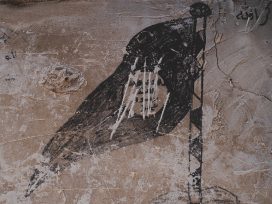
‘Practically every home in Pankisi bears the scars of the Second Chechen War, the Abkhazian War and the Syrian War. Practically every home has ties to the Islamic State.’ In this excerpt from her book ‘Goodbye, Isis: What Remains is Future’, Kateryna Sergatskova travels to the birthplace of Tarkhan Batirashvili, aka Omar al-Shishani, the former IS ‘Minister of War’.

Growing numbers of Russians are fleeing the stifling atmosphere that has settled across the country’s political and cultural realms. Nowhere is this more tangible than in the world of popular music – once a shared cultural space between the two nations, now just another battleground in Russia’s war against Ukraine.

